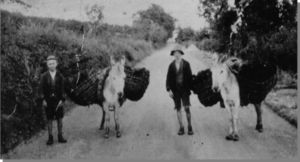Three to a spade
| “ | Planted boglands show that time has changed the farmer’s way of life. From the 1930s until oil succeeded turf as the most popular fuel, Tommy Johnston worked on a bog at Coolnasilla. He says, “fifty families cut turf out there and you know there’s not one in that whole area now”. When the weather is good enough, Tommy still wins turf from a small bank but such farmers are now a rare sight.
Turf, being so plentiful in the area, was the only fuel used around Killyfole before and during the War. In an era when everything was done by hand, wood was rarely burnt as fuel. “There was no such thing as a chain-saw” says Tommy, “there was a big, long saw and a man at each end of it. That’s what you called a cross-cut. So you motored away at that and I tell you, it was a big job tossing a tree and getting it cut up and lifted.” Tommy began working at the bog as a ten year old child. Besides acting “the Canat” by throwing clods of turf at his friends, his tasks included carrying the food basket over the mountain to the bog, lighting the fire and cooking meals of tea and boiled eggs, which everyone ate at the bog. Work in the bog was hungry work and lasted all day. It took at least three people to work the bog; one to cut, one to throw the turf into the wheelbarrow and another to spread, that’s what they called ‘three to a spade’ explains Tommy. The only time two people could work a bog was during the cutting of Bentey turf. Bentey turf was only one floor deep so there was no need for a wheelbarrow to bring the turf away. The person collecting the turf could simply throw the turf on to the bank to dry. Tommy says that the Bentey turf was very tough : “You could throw a piece to the road and it wouldn’t break. They are the best turf you can buy”. There were almost 20 bogs worked by local farmers at one stage and some farmers made mud turf instead of the usual turf. Mud turf was soft turf mixed with water. Farmers mixed the water and clods of turf into a thick mud and laid it out in layers on the bank. They marked it into squares the size of turf and when it was dry, the turf would rise up in the shapes of squares. At a time when there was no machinery and everything was done by hand, accidents on the bog were almost unheard of. “The only accident that could happen would be if you got greedy and started picking up the turf too close to the man that was cutting them. He could nick you with the spade and the spade was always very sharp. He cut a row and you were supposed to keep back three turf from him”, says Tommy. “When the turf was cut and dried, it was brought home. “If the way into your bog was suitable you drew them home in a horse and cart. Otherwise the turf were taken out by donkey and creels. I remember seeing my Uncle Bob with a string of 20 asses bringing out turf. The rule was ‘the laden ass has the pass’ that is, if you met them, you got out of their way. Farmers sold the turf in stacks of ten or twelve cartloads on the side of the road. In wartime, lorries from Monaghan used to come to collect the turf and companies paid £8-£9 for a stack.”  Once oil became popular, the bogs were no longer used. Much of the bogland in the Killyfole area is now planted with fir trees. Yet Tommy does not think the bog culture has been lost for eternity : “Maybe some day it’ll come back again. If oil ran out you’d see plenty of men back out on the bog. People still need a fire. With coalmines in England shutting down, you could see that if oil was cut off to-morrow there’d be a famine for heat.” |
” |
—By Tommy Johnston, ] | ||